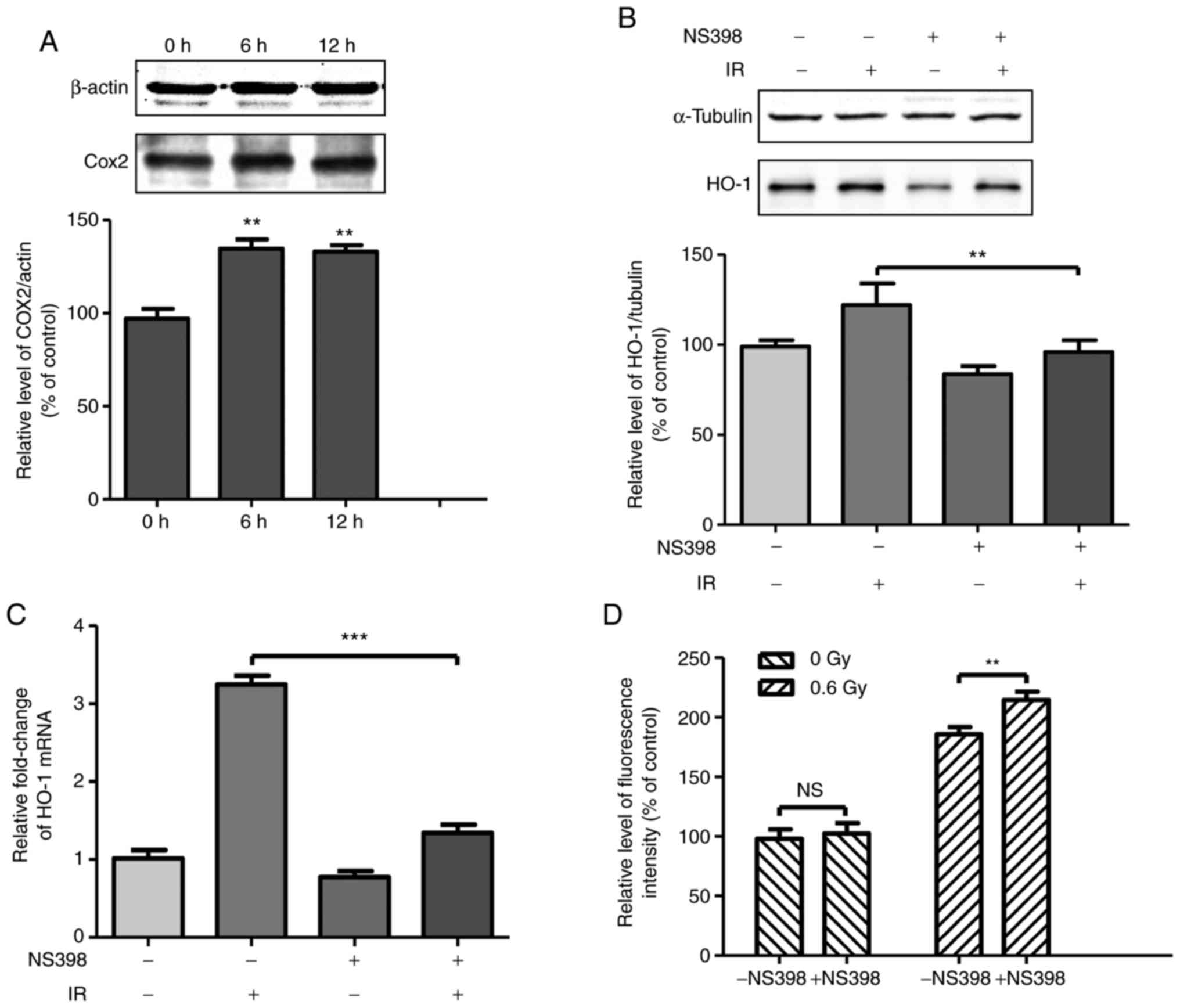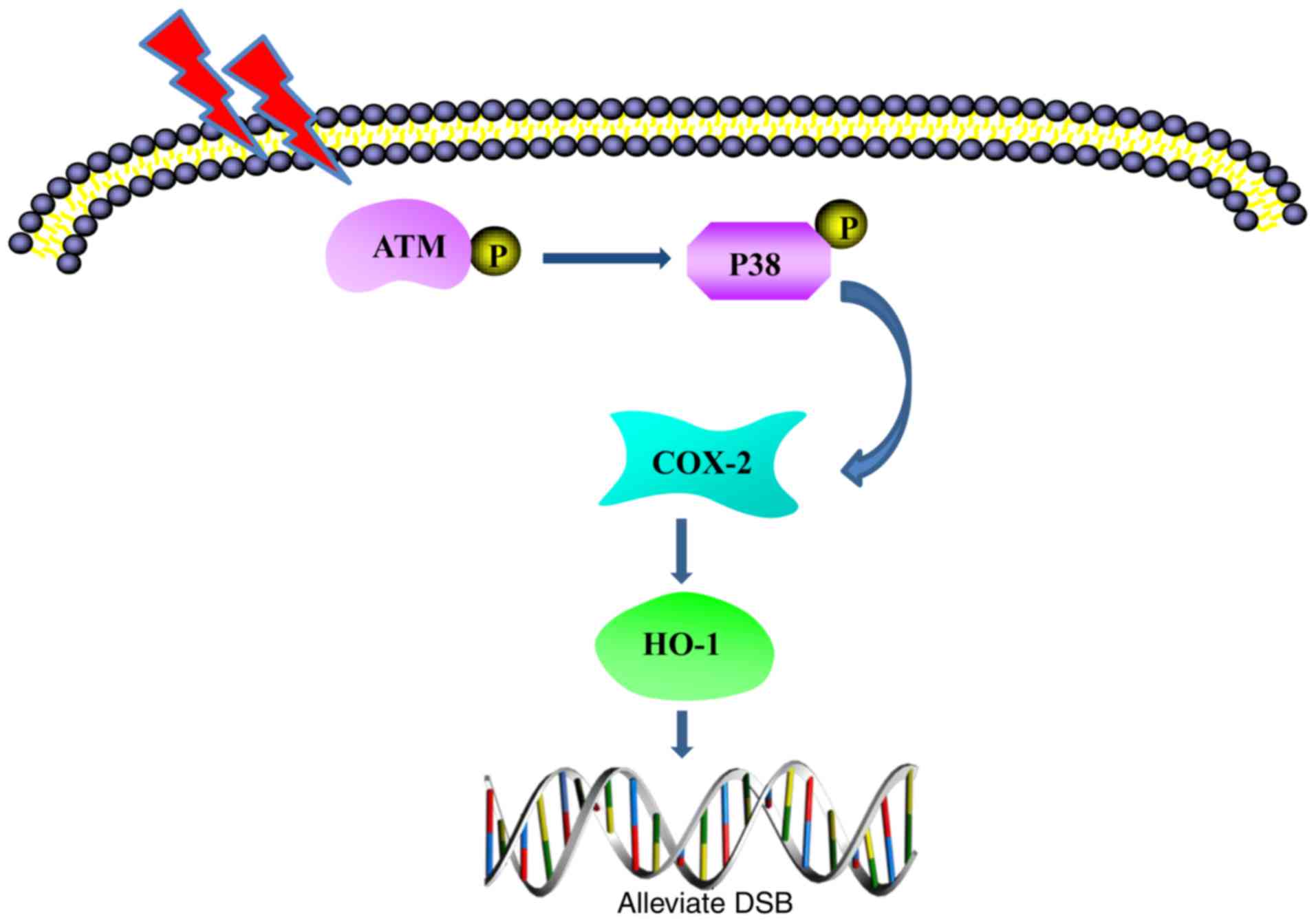|
1
|
Lomax ME, Folkes LK and O'Neill P:
Biological consequences of radiation-induced DNA damage: Relevance
to radiotherapy. Clin Oncol (R Coll Radiol). 25:578–585. 2013.
View Article : Google Scholar
|
|
2
|
Najafi M, Motevaseli E, Shirazi A, Geraily
G, Rezaeyan A, Norouzi F, Rezapoor S and Abdollahi H: Mechanisms of
inflammatory responses to radiation and normal tissues toxicity:
Clinical implications. Int J Radiat Biol. 94:335–356. 2018.
View Article : Google Scholar : PubMed/NCBI
|
|
3
|
Gozzelino R, Jeney V and Soares MP:
Mechanisms of cell protection by heme oxygenase-1. Annu Rev
Pharmacol Toxicol. 50:323–354. 2010. View Article : Google Scholar : PubMed/NCBI
|
|
4
|
Vile GF, Basu-Modak S, Waltner C and
Tyrrell RM: Heme oxygenase 1mediates an adaptive response to
oxidative stress in human skin fibroblasts. Proc Natl Acad Sci USA.
91:2607–2610. 1994. View Article : Google Scholar
|
|
5
|
Otterbein LE and Choi AM: Heme oxygenase:
Colors of defense against cellular stress. Am J Physiol Lung Cell
Mol Physiol. 279:L1029–L1037. 2000. View Article : Google Scholar : PubMed/NCBI
|
|
6
|
Ryter SW, Alam J and Choi AM: Heme
oxygenase-1/carbon monoxide: From basic science to therapeutic
applications. Physiol Rev. 86:583–650. 2006. View Article : Google Scholar : PubMed/NCBI
|
|
7
|
Soares MP, Marguti I, Cunha A and Larsen
R: Immunoregulatory effects of HO-1: How does it work? Curr Opin
Pharmacol. 9:482–489. 2009. View Article : Google Scholar : PubMed/NCBI
|
|
8
|
Paine A, Eiz-Vesper B, Blasczyk R and
Immenschuh S: Signaling to heme oxygenase-1 and its
anti-inflammatory therapeutic potential. Biochem Pharmacol.
80:1895–1903. 2010. View Article : Google Scholar : PubMed/NCBI
|
|
9
|
Pang LY, Hurst EA and Argyle DJ:
Cyclooxygenase-2: A role in cancer stem cell survival and
repopulation of cancer cells during therapy. Stem Cells Int.
2016:20487312016. View Article : Google Scholar : PubMed/NCBI
|
|
10
|
Tang FR and Loke WK: Molecular mechanisms
of low dose ionizing radiation-induced hormesis, adaptive
responses, radio-resistance, bystander effects, and genomic
instability. Int J Radiat Biol. 91:13–27. 2015. View Article : Google Scholar
|
|
11
|
Salehifar E and Hosseinimehr SJ: The use
of cyclooxygenase-2 inhibitors for improvement of efficacy of
radiotherapy in cancers. Drug Discov Today. 21:654–662. 2016.
View Article : Google Scholar : PubMed/NCBI
|
|
12
|
Rosser CJ, Gaar M and Porvasnik S:
Molecular fingerprinting of radiation resistant tumors: Can we
apprehend and rehabilitate the suspects? BMC Cancer. 9:2252009.
View Article : Google Scholar : PubMed/NCBI
|
|
13
|
Komaki R, Liao Z and Milas L: Improvement
strategies for molecular targeting: Cyclooxygenase-2 inhibitors as
radiosensitizers for non-small cell lung cancer. Semin Oncol.
31(Suppl 1): S47–S53. 2004. View Article : Google Scholar
|
|
14
|
Nie B, Ni M and Wei S: Individual dose due
to radioactivity accidental release from fusion reactor. J Hazard
Mater. 327:135–143. 2017. View Article : Google Scholar : PubMed/NCBI
|
|
15
|
Wu Y: Development of high intensity D-T
fusion neutrongenerator HINEG. Int J Energy Res. 42:68–72. 2016.
View Article : Google Scholar
|
|
16
|
Bustin SA, Benes V, Garson JA, Hellemans
J, Huggett J, Kubista M, Mueller R, Nolan T, Pfaffl MW, Shipley GL,
et al: The MIQE guidelines: Minimum information for publication of
quantitative real-time PCR experiments. Clin Chem. 54:611–622.
2009. View Article : Google Scholar
|
|
17
|
Tran V and Little MP: Dose and dose rate
extrapolation factors for malignant and non-malignant health
endpoints after exposure to gamma and neutron radiation. Radiat
Environ Biophys. 56:299–328. 2017. View Article : Google Scholar : PubMed/NCBI
|
|
18
|
Broustas CG, Xu Y, Harken AD, Chowdhury M,
Garty G and Amundson SA: Impact of neutron exposure on global gene
expression in a human peripheral blood model. Radiat Res.
187:433–440. 2017. View
Article : Google Scholar : PubMed/NCBI
|
|
19
|
Tanaka K, Gajendiran N, Endo S, Komatsu K,
Hoshi M and Kamada N: Neutron energy-dependent initial DNA damage
and chromosomal exchange. J Radiat Res. 40(Suppl): S36–S44. 1999.
View Article : Google Scholar
|
|
20
|
Otterbein LE, Hedblom A, Harris C,
Csizmadia E, Gallo D and Wegiel B: Heme oxygenase-1 and carbon
monoxide modulate DNA repair through ataxia-telangiectasia mutated
(ATM) protein. Proc Natl Acad Sci USA. 108:14491–14496. 2011.
View Article : Google Scholar : PubMed/NCBI
|
|
21
|
Chen N, Wu L, Yuan H and Wang J:
ROS/Autophagy/Nrf2 pathway mediated low-dose radiation induced
radio-resistance in human lung adenocarcinoma A549 cell. Int J Biol
Sci. 11:833–844. 2015. View Article : Google Scholar : PubMed/NCBI
|
|
22
|
Han W, Yu KN, Wu LJ, Wu YC and Wang HZ:
Mechanism of protection of bystander cells by exogenous carbon
monoxide: Impaired response to damage signal of radiation-induced
bystander effect. Mutat Res. 709–710:1–6. 2011. View Article : Google Scholar
|
|
23
|
Singh A, Yashavarddhan MH, Kalita B,
Ranjan R, Bajaj S, Prakash H and Gupta ML: Podophyllotoxin and
Rutin modulates ionizing radiation-induced oxidative stress and
apoptotic cell death in mice bone marrow and spleen. Front Immunol.
8:1832017. View Article : Google Scholar : PubMed/NCBI
|
|
24
|
Hofer M, Hoferová Z, Dušek L, Souček K and
Gruzdev A: Hematological profile of untreated or ionizing
radiation-exposed cyclooxygenase-2-deficient mice. Physiol Res.
66:673–676. 2017.PubMed/NCBI
|
|
25
|
Ozbilgin MK, Onal T, Ozcan C, Temel M,
Aktas C, Gareveran MS, Uluer ET, Inan S and Kurtman C: Effects of
cyclooxygenase on the urothelium of the urinary bladder of mice
exposed to pelvic radiation. Anal Quant Cytopathol Histpathol.
38:103–110. 2016.PubMed/NCBI
|
|
26
|
Zuo Z, Ouyang W, Li J, Costa M and Huang
C: Cyclooxygenase-2 (COX-2) mediates arsenite inhibition of
UVB-induced cellular apoptosis in mouse epidermal Cl41 cells. Curr
Cancer Drug Targets. 12:607–616. 2012. View Article : Google Scholar : PubMed/NCBI
|
|
27
|
Clouaire T, Marnef A and Legube G: Taming
tricky DSBs: ATM on duty. DNA Repair (Amst). 56:84–91. 2017.
View Article : Google Scholar
|
|
28
|
Thompson LH: Recognition, signaling, and
repair of DNA double-strand breaks produced by ionizing radiation
in mammalian cells: The molecular choreography. Mutat Res.
751:158–246. 2012. View Article : Google Scholar : PubMed/NCBI
|
|
29
|
Park SY, Kim YM and Pyo H: Gefitinib
radiosensitizes non-small cell lung cancer cells through inhibition
of ataxia telangiectasia mutated. Mol Cancer. 9:2222010. View Article : Google Scholar : PubMed/NCBI
|
|
30
|
Chacko T, Menon A, Majeed T, Nair SV, John
NS and Nair CKK: Mitigation of whole-body gamma radiation-induced
damages by Clerodendron infortunatum in mammalian organisms. J
Radiat Res. 58:281–291. 2017.
|
|
31
|
Kim YM and Pyo H: Cooperative enhancement
of radiosensitivity after combined treatment of
17-(allylamino)-17-demethoxygel-danamycin and celecoxib in human
lung and colon cancer cell lines. DNA Cell Biol. 31:15–29. 2012.
View Article : Google Scholar :
|
|
32
|
Dent P, Yacoub A, Fisher PB, Hagan MP and
Grant S: MAPK pathways in radiation responses. Oncogene.
22:5885–5896. 2003. View Article : Google Scholar : PubMed/NCBI
|
|
33
|
Munshi A and Ramesh R: Mitogen-activated
protein kinases and their role in radiation response. Genes Cancer.
4:401–408. 2013. View Article : Google Scholar : PubMed/NCBI
|
|
34
|
Acheva A, Schettino G and Prise KM:
Pro-inflammatory signaling in a 3D organotypic skin model after low
LET irradiation-NF-κB, COX-2 activation, and impact on cell
differentiation. Front Immunol. 8:822017. View Article : Google Scholar
|
|
35
|
Hung JH, Su IJ, Lei HY, Wang HC, Lin WC,
Chang WT, Huang W, Chang WC, Chang YS, Chen CC and Lai MD:
Endoplasmic reticulum stress stimulates the expression of
cyclooxygenase-2 through activation of NF-kappaB and pp38
mitogen-activated protein kinase. J Biol Chem. 279:46384–46392.
2004. View Article : Google Scholar : PubMed/NCBI
|
|
36
|
Tessner TG, Muhale F, Schloemann S, Cohn
SM, Morrison AR and Stenson WF: Ionizing radiation up-regulates
cyclooxygenase-2 in I407 cells through p38 mitogen-activated
protein kinase. Carcinogenesis. 25:37–45. 2004. View Article : Google Scholar
|
|
37
|
Hu YP, Peng YB, Zhang YF, Wang Y, Yu WR,
Yao M and Fu XJ: Reactive oxygen species mediated prostaglandin E2
contributes to acute response of epithelial injury. Oxid Med Cell
Longev. 2017:41238542017. View Article : Google Scholar :
|















